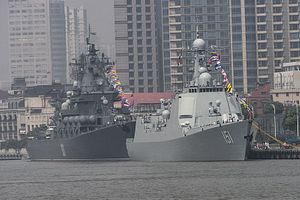Chinese and Russian naval officials have concluded planning a large joint Sino-Russian maritime exercise to be held in late August, according to the Russian TASS wire service.
Russian Pacific Fleet spokesman Roman Martov told TASS that a protocol on the Join Sea-2015(II) naval drill was signed in Vladivostok last Friday.
“Representatives of the headquarters of the Russian Pacific Fleet and the Navy of the People’s Liberation Army of China have carried out major work for the planning of the Chinese warships’ visit to Vladivostok port, the cultural program, sports competitions and all the tactical events of the sea, land, and air parts of the maneuvers,” Martov noted.
The exercise will take place in the Sea of Japan and off the coast of Russia’s Primorsky territory — approximately 250 miles away from Japan — and include for the first time a joint amphibious assault drill.
The 20 warships and support vessels from both navies will also be joined by carrier-based aircraft, Martov told TASS. Russia’s Pacific Fleet consists of around 70 vessels including four landing ships and five landing crafts. China is currently in the process of expanding its fleet of amphibious warfare ships with the construction and gradual induction of six new Type-071 Yuzhao-class vessels.
In May 2015, China and Russia held a much smaller naval drill code-named “Joint Sea 2015” that involved nine ships from both countries in the Mediterranean Sea. The navies conducted live-fire drills, underway replenishment and escort operations (see: “China and Russia Conclude Naval Drill in Mediterranean”).
Similar to the Sino-Russian naval exercise in May, the maneuvers taking place in August will aim to bolster equipment interoperability but are also meant to send a clear political signal to the United States and its allies in the region that Sino-Russian military ties are deepening.
At the end of June, the Chinese ambassador to Russia, Li Hui, told Russian media that both countries plan to expand military cooperation:
China hopes to develop an all-around and broad cooperation with Russia, including in military-technical cooperation, to gradually strengthen practical cooperation of the two states [as well as strengthen] friendly exchanges between the peoples of our countries.
However, he emphasized that this should not be perceived as “creating a military coalition in any form.” Beijing and Moscow have held regular joint naval drills since 2011.
When the “Joint Sea 2015” naval drill was announced in November 2014, Russian Defense Minister Sergei Shoigu said that joint military exercises are part of a development that “has visibly expanded and gained a systemic character.”
“We believe that the main goal of pooling our effort is to shape a collective regional security system. (…) We also expressed concern over U.S. attempts to strengthen its military and political clout in the [Asia-Pacific Region],” he added when explaining the rationale behind closer military ties, according to USNI News.
































